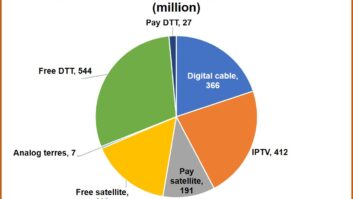Organic light-emitting diode (OLED) display technology is set to make only minor inroads into the television market during the next few years, iSuppli Corp predicts. Currently mainly used in mobile-phone displays, iSuppli suggests that quantities will rise but technical problems will stymie widescale adoption.
The prediction is for OLED TV shipments to rise at a compound annual growth rate (CAGR) of 170.6% to reach 1.2 million units in 2012, up from 8,000 in 2007. Sales revenue for OLED-TVs, meanwhile, will increase to $691 million in 2012, rising from less than $1 million in 2007.
“Interest in OLED-TVs has been stimulated by Sony Corp’s recent announcement that it will offer a product using the technology by the end of the year,” said Vinita Jakhanwal, principal analyst for mobile displays at iSuppli. “Sony cited OLEDs’ ultra-thin form factor and higher contrast and richer colours compared to conventional LCD TVs.”
In response to Sony’s announcement, Toshiba Matsushita Display (TMD), the display arm of the consumer electronics giant Matsushita, also announced accelerated availability of 20.8-in Active-Matrix OLED (AMOLED) panels for OLED-TVs, Jakhanwal added.
Indeed, AMOLED technology is suitable for television in many regards, iSuppli believes. OLEDs offer fast response time, good colour, high brightness, excellent viewing angles and high contrast ratios. Furthermore, OLEDs don’t need backlights, making them potentially thinner than the alternative flat-panel technologies on the market.
Moreover, the resolutions needed in the television market are attainable with OLEDs. OLED TVs in larger sizes, ie greater than 20-ins, could be sold by the 2012 timeframe. Most likely these TVs will use polymer panels made by inkjet printing in the largest sizes, but small-molecule OLEDs made by evaporation techniques also could be used in televisions.
However, there are shortcomings to OLED technology that will prevent wider adoption in the television market. The main challenges are poor manufacturing yields, limited lifetimes and pricing.
Manufacturing processes for AMOLEDs now are being tested for small sizes like 2.0-inches and 2.4-ins. Manufacturing these small sized panels is proving to be a challenge. Producing AMOLEDs in larger sizes will be an even greater challenge. More time is needed to establish manufacturing processes for large panels, and to build equipment that can make such panels efficiently. Inkjet printers for fourth generation substrates are still in the beta testing phase.
Thus, it is likely that the first OLED-TVs will be small and designed for novel locations such as kitchens or bathrooms. The total available market for this sort of television is small. Later, as technical and manufacturing capabilities grow, OLEDs may move into more standard-sized TVs at dimensions of 20-ins or larger. This will happen near the end of the forecast, but only with continued investments and commitments from major polymer OLED suppliers.
Due to high manufacturing costs, AMOLEDs are expected to be considerably more expensive than LCD panels for the foreseeable future. OLED TV panels are expected to be twice as expensive as LCD TV panels in 2011.
Another challenge for OLEDs in the television market is the large number of competitive technologies vying for a share of sales. The television market already is flooded with options: CRT, LCD, plasma, four types of projection systems and the potential for a variety of novel technologies like surface-conduction electron-emitter display (SED) and carbon-nanotube field emission display (FED).
Consumers, for the most part, do not care about particular technologies. Instead they tend to look only at the picture quality and the price, and secondarily at the size and depth. This may make it difficult for OLEDs to gain consumer awareness. The plethora of technologies also may make it hard for OLED TV to attract the attention of end-product OEMs and channel vendors.
Because of this, OLED will be limited to less than half of 1% of the 242.7 million unit worldwide television market in 2011, according to iSuppli.







